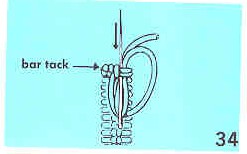|
Page 2 |
|||
Buttonholes |
|
||
|
Hand-Worked Buttonholes The regular hand-worked buttonhole provides a more careful finish in many cases where a machine-worked one might do. The keyhole buttonhole, generally corded, is used in tailored garments. The thread you use should be waxed to prevent curling and knotting, but this must be done sparingly to avoid staining the fabric. A good hand-worked buttonhole has stitches worked close together, stitches of even depth. Regular Hand-Worked Buttonhole The regular buttonhole may be horizontal, with a rounded fan-end near the garment edge (where the button rests), and a bar tack at the other end; or vertical, with the same finish at both ends, either fans or bar tacks. The thread you use (waxed) depends on your fabric. It may be regular sewing thread, single (for a 1” buttonhole, cut a 30” length), or double (cut 65” and double), or buttonhole twist (cut 36”).
Start at bar end. With a knot at thread-end, insert needle into right side of fabric about ½” from bar end, and bring it out through the slit at that end (30). (The knot will be removed later.) Cover edges with buttonhole stitch (see below), making a fan or a bar tack at ends.
Buttonhole stitch is worked from right to left, with the needle pointing toward you. Use the machine stitching as a guide for stitch depth (except at fan end). Loop the thread as shown (31) and insert needle into slit, bringing it out just below stitching with eye and point over the looped thread. Draw up needle away from you so that the purl (32) is formed at edge of slit. Do not draw up the thread too tight.
The bar tack is made by taking two stitches at buttonhole end, across both rows, and then working over these threads with blanket stitch without catching the fabric. Use the needle eye-first, as shown (34). Then put the needle through to wrong side.
|
|||
|
|
|||
|
|
|||
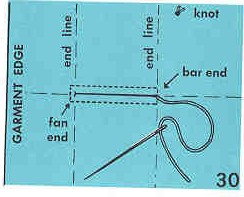 For this buttonhole, the slit is cut before the edges are worked over. Before cutting the slit, however, reinforce the edges: either make a line of straight machine-stitching (20 stitches to the inch) 1/16” to each side of the position line; or work a narrow machine-buttonhole over the position. Then cut the slit between the end lines (30).
For this buttonhole, the slit is cut before the edges are worked over. Before cutting the slit, however, reinforce the edges: either make a line of straight machine-stitching (20 stitches to the inch) 1/16” to each side of the position line; or work a narrow machine-buttonhole over the position. Then cut the slit between the end lines (30).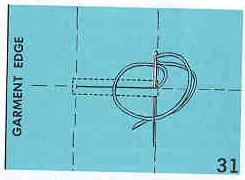 Finish off thread-ends carefully. Clip off the thread used for starting, and pull out the knot.
Finish off thread-ends carefully. Clip off the thread used for starting, and pull out the knot.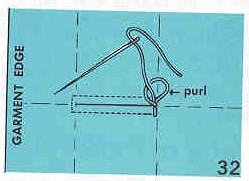
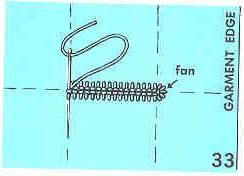 The fan is worked around the end as shown. Keep stitch-depth even and turn gradually (33).
The fan is worked around the end as shown. Keep stitch-depth even and turn gradually (33).